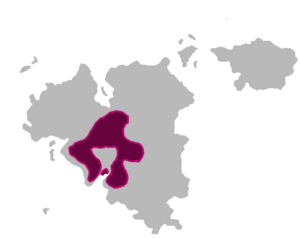Beatricism
This article is non-canonical either because it refers to out-of-character content, the associated nations have left the region, or the information has been retconned. Accordingly, its content should not be considered to be part of the canonical structure of the region's lore.
|
Beatricism, sometimes referred to as the Cult of Beatrice, is the name of a syncretic religion that rose to prominence in 13th century Aciria following the death of Saint Beatrice. Beatricism was born after early pagans who were introduced to Catholicism through Saint Beatrice found common ground between various beliefs of Catholicism and their traditional folk religion, most notably the holy trinity and the Three Sisters. Many associated the Three Sisters and the Holy Trinity as one and the same, with Beatrice being both the supreme being Taia and God walking the earth.
The term Beatricism has been criticised by some historians as inaccurate, as various sects of Beatricism existed with both differing beliefs and differing amounts of Catholic or pagan influence in them. The persecution by the Catholic church brought the religion to an end, but some scholars have suggested that Beatricism was simply absorbed into Acirian Catholicism with Beatricists simply beginning to identify as Catholics instead. The theory is supported by the high levels of veneration she enjoys to this day.
History
While Catholicism had a notable presence in the coastal regions, inland and particularly the central highlands were fairly untouched by Catholicism. Beatrice's fathers conversion to Catholicism and Beatrice's efforts to educate the tribe of Catholicism was the first notable Catholic presence in the highlands, with the conversion greatly upsetting many nearby tribes. The tribesmen Beatrice preached to were particularly open to Beatrice herself rather than the religion, due to many finding similarities between her and the holy women of their pagan religion. The continued exposure to Catholicism allowed the tribesmen to find more similarities between the two faiths, which made the adoption of some concepts easier than others, most notably the Holy Trinity due to its similarity to the belief of the Three Sisters.
During the life of Beatrice, the religion what eventually developed into Beatricism focused on combining bits and pieces of Catholicism with what fit the pagan religion. The veneration of Beatrice and the identification of her as both Taia and Christ became only after her sacrifice at River Ripulire, with many drawing similarities between her death to save her tribesmen with Christ's sacrifice on the cross. The tribesmen that successfully evacuated closer to the coast quickly began preaching their new syncretic faith to their tribal neighbours, which they were more open to adopting than Catholicism. The religion was closer to Catholicism than their folk religion, which then enabled them to trade with Catholics easier, but not strange enough to be a foreign religion that should be rejected.
As Beatricism spread in central and southern Aciria, differing sects of Beatricism were born. Most notable of those are now referred to as the Salvatori, who lacked belief in Beatrice being Christ or Taia, but instead believed Beatrice to be the bride of Christ, associating her with the pagan goddess Racia, sometimes described as Taia's bride who walked the earth before Taia's appearance to restart the time cycle. The Salvatori also associated Taia with Christ instead, believing that Christ would soon bring the kingdom of heaven down to earth. The Salvatori also were far more violent in spreading their faith, arming themselves to spread the faith in order to save both themselves and as many others when the kingdom of heaven was brought to earth.

A notable rival to Catholicism in its early years, Beatricism maintained a strong presence in central Aciria while Catholicism took over the coast. The Catholic church only began large-scale efforts to push further inland in the 15th century onward, which resulted in conflict between the two faiths. Catholicism eventually won the conflict, beginning the persecution of Beatricists, leading to a quick decline in Beatricism. It's unsure how widespread Beatricist conversion to Catholicism was, but some speculate many Beatricists were Catholic only in name, practising Beatricism in secret.
Beatricism today
Beatricism saw a slow resurgence in popularity following Giovanni I's ascension to the throne, and him legalising Beatricism once more to distinguish the new state. Some who personally knew Giovanni I even went as far to say that he was a practising Beatricist himself, but no concrete evidence of this exists. The faith has remained a small minority in the country since, with Beatricist churches present in all major cities of Aciria, particularly the capital.